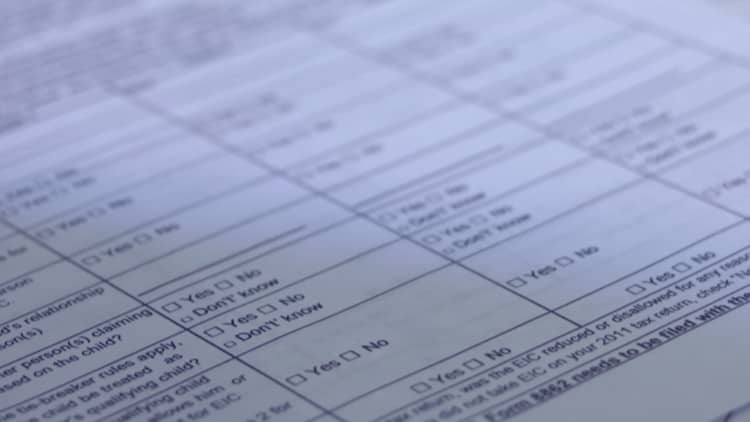As taxpayers roll into the second tax-filing season under the Tax Cuts and Jobs Act, one question remains: "Will I come out ahead in 2019?"
The IRS began accepting 2019 tax returns on Jan. 27 and anticipates it will receive more than 150 million individual returns this year.
Thus far, the agency has delivered 4.3 million refunds to early-bird filers, distributing an average check of $1,869 to those households, according to IRS data for the week of Jan. 31.
More from Smart Tax Planning:
Trump wants to extend his tax overhaul. What it means for you
One in 5 fear they'll owe the IRS money this spring
Tax season is here! What you need to make it easy
Resist the urge to use the refund to determine whether you're ultimately benefitting from the 2018 tax overhaul. The check you get back from Uncle Sam only tells part of the story.
"The number of people who think they're worse off versus those who are actually worse off is driven by this perception of whether the refund went up or down," said Ed Zollars, CPA at Thomas Zollars & Lynch in Phoenix.
"I'm looking at returns, and I'll say a majority of people saved on taxes, but I will not say that a majority of people saw their refunds go higher," he said. "That's where the disconnect is."
Here's who came out ahead and how to determine whether you're a winner.
Lower rates, higher standard deduction

The Tax Cuts and Jobs Act trimmed individual tax rates overall, lowering the top rate to 37% from 39.6%.
Corporations also saw their levies fall, as their income tax rates declined to 21% from 35%.
At the same time, the standard deduction for single filers went up to $12,000 in 2018 from $6,350 in 2017 (married filers with joint returns saw their standard deduction rise to $24,000 from $12,700).
The 2018 tax overhaul also curbed certain itemized deductions.
It also did away with personal exemptions, which once were $4,050 for yourself and each dependent in your household.
Due to the higher standard deduction, fewer people itemized on their returns.
More than 14.6 million individual income tax returns claimed itemized deductions, such as charitable giving write-offs and property taxes paid, during the 2018 tax year, according to IRS data through July 25, 2019 – the most recent figures available.
In comparison, 42.2 million returns filed for the 2017 tax year used itemized deductions, according to IRS data through July 25, 2018.
The right withholding is key
Hefty refund checks suggest that you overpaid Uncle Sam during the prior year. It also means you took home less money.
"Sure, you can have a bigger refund, but you're going to have less money in your pocket," said Joseph Perry, national tax and business services leader at Marcum LLP.
Meanwhile, a balance due means you had too few taxes withheld from your pay — a situation some taxpayers found themselves in after the Treasury Department and IRS overhauled the tax withholding tables for the new law.

"Your refund or taxes due on April 15 isn't really your tax," said Zollars. "You're just truing up for the year."
To see how you really fared in the prior year, look at your tax liability.
That means examining line 16 of your 2019 Form 1040 and comparing it to line 15 of your 2018 individual income tax return.
Winners: high earners who formerly paid the AMT
Under the old law, taxpayers with higher incomes were subject to something known as the alternative minimum tax.
These filers would calculate their income tax liability twice: once under the ordinary rules and again with the AMT, which would bar you from claiming certain write-offs and itemized deductions.
You would then look at your liabilities under the ordinary rules and the AMT and pay whichever tax was the highest.
The number of people who think they're worse off versus those who are actually worse off is driven by this perception of whether the refund went up or down.Ed ZollarsCPA at Thomas Zollars & Lynch
The Tax Cuts and Jobs Act raised the 2018 AMT exemption to $109,400 for married taxpayers, from $84,500. For single filers, the exemption rose to $70,300, from $54,300.
The AMT tweak is forecast to reduce the number of people paying the AMT to 200,000 per year through 2025 – which is when this change will expire — compared to 5 million in 2017, prior to the tax overhaul, the Tax Policy Center found.
"Under today's laws, it's highly unlikely you'll be in the AMT, said Jeffrey Levine, CPA and CEO of BluePrint Wealth Alliance in Garden City, New York.
Losers: residents of high-tax states
The upside of residing in states with high income and property taxes — including New Jersey, New York and California — was that you could write off tens of thousands of dollars in state and local levies (known as SALT) if you itemized your tax return.
For instance, New Yorkers who itemized returns in 2017 claimed an average state and local tax deduction of $23,804, according to the Tax Policy Center.
Under the new law, that write-off has been limited to $10,000.
"You can argue that those who live in Florida or in other low or zero state tax places fared better compared to high-tax states," said John Voltaggio, CPA and managing director at Northern Trust.
Be aware that if you were hit by the AMT under the old law, you were probably not benefiting from the SALT deduction, either. "They weren't able to deduct it anyway because of AMT," Voltaggio said.
Winners: families with kids under 17
The 2018 tax overhaul doubled the child tax credit to $2,000 per kid under age 17. Higher-income households are also able to claim this break.
Under the old law, the child tax credit began to phase out at $75,000 of adjusted gross income for single taxpayers ($110,000 for married filing jointly).
Today, the phaseout of the child tax credit starts at $200,000 of AGI for singles or $400,000 for married couples.
Losers: people who didn't adjust their withholding
When the IRS updated its tax-withholding tables to reflect the new law, it also revamped its Form W-4 — a document employees use to ensure they're pulling enough income tax from their paycheck.
Some taxpayers are at risk of paying too little tax during the year, including former itemizers and individuals with side gigs.
"If you're making side income, you have no withholding on it, then you've underpaid the taxes and you ultimately owe money," Perry said.
If you were significantly underwithheld in 2019, it's too late to right the ship.
However, you can head off a similar disappointment next year if you get your prior year's tax return and crunch the numbers on the IRS's tax withholding calculator.





